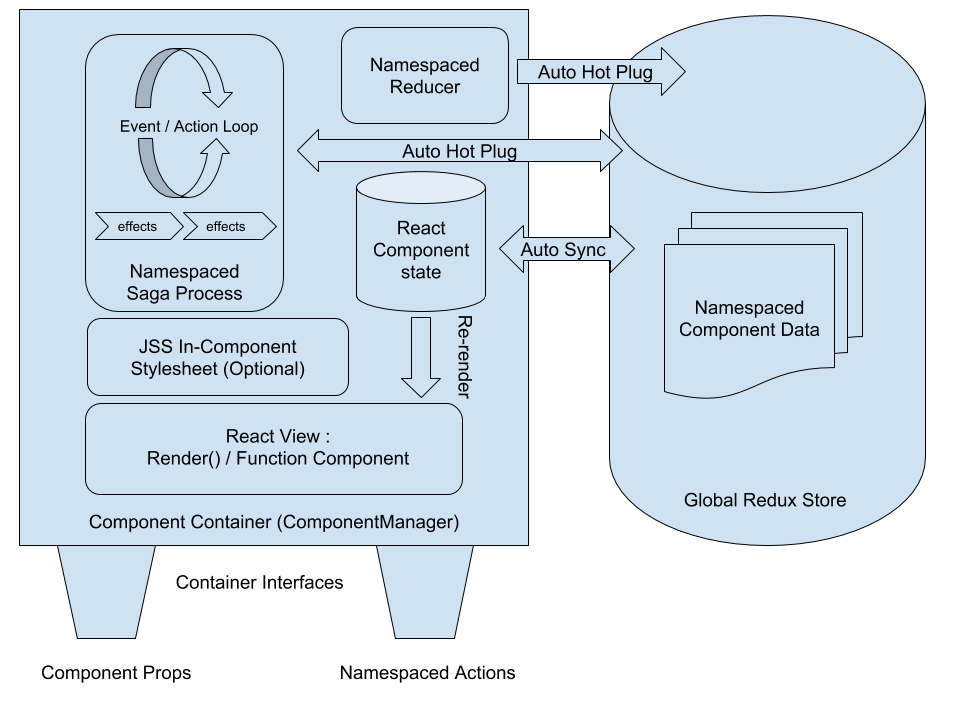ComponentManager
Overview
An instance of ComponentManager will be created when register a React Class or Function Component to the AppContainer via new ComponentManager() (for React Class Components) or useComponentManager Hook (for React Function Components).
Once the Component Manager is created, a Component Container structure is created behind the scenes to maintain a more advanced component structure as illustrated by the diagram below. After that, you no longer can call this.setState to update your react class component state. Instead, you should update your component state via Component Reducer (you can supply via ManageableComponentOptions) and system will auto sync between Redux store and your component state.

An instance of ComponentManager is responsible for:
- Locate AppContainer instance and register itself to the located AppContainer instance
ComponentManagerwill try to locate AppContainer via:- Component Props
appContainer - Or Context
- Or an automatically created global shared default AppContainer
- Component Props
- Create namespaced Saga, register it with
AppContainer& terminate / cancel it when the component is unmounted - Create, Hot plug namespaced Reducer with
AppContainer& unplug it when the component is unmounted - Register namespaced Action so they can be serialised if necessary
- Manage any other namespaced data
Create Component Manager
Manage Class Component
Component Manager can be created by creating an instance of the ComponentManager class using new operator:
const componentManager = new ComponentManager(manageableComponent, manageableComponentOptions);
ManageableComponent
Here, manageableComponent is a React Class Component instance. You can get the reference of the React Class Component as this within any of its class methods. However, in order to let fractal-component manage your component probably, you will need to create Component Manager in your component class's constructor method. e.g.:
import React from "react";
import { ComponentManager, AppContainerContext } from "fractal-component";
class MyComponent extends React.Component {
constructor(props) {
this.componentManager = new ComponentManager(this, {
// --- all manageableComponentOptions goes here. Details see next section
....
});
}
render() {...}
}
// --- This allows ComponentManager to locate the `AppContainer`
// --- via `React Context API` without using `Context.Consumer` component
MyComponent.contextType = AppContainerContext;
ManageableComponentOptions
More details of ManageableComponentOptions can be found from here.
Key Properties
You may need to access the following public properties of a ComponentManager instance:
namespace: String. thenamespaceof theComponent Container. e.g.io.github.t83714/RandomGifcomponentId: String. the auto-genereatedcomponentId. e.g.c0namespacePrefix: String. thenamespacePrefixof theComponent Container. e.g.ExampleApp/RandomGifDemo. All managed components will accept anamespacePrefixcomponentprops. The value of thispropswill overwrite thenamespacePrefixoption provided via ManageableComponentOptions. This allows your component users to customise / config your component action dispatch behaviour.fullPath: String.Full Namespace Pathof theComponent Container. e.g.ExampleApp/RandomGifDemo/io.github.t83714/RandomGiflocalPath: String:namesapce+ComponentId. e.g.io.github.t83714/RandomGif/c0
dispatch()
The method's type declaration is shown as below:
dispatch(action: Action, relativeDispatchPath?: string): Action;
You can use this method to dispatch namespaced actions:
import React from "react";
import { ComponentManager } from "fractal-component";
class RandomGif extends React.Component {
constructor(props) {
super(props);
this.componentManager = new ComponentManager(this, {
namespace: "io.github.t83714/RandomGif"
});
}
render() {
return <button onClick={()=>{
/*
* Dispatch namespaced action:
* The component's runtime local namespace path should be:
* `io.github.t83714/RandomGif/xx` xx is an auto-generated ID
* `../../../*` will make action to be dispatched just out of the container
*/
this.componentManager.dispatch({}, "../../../*");
}}>Click me!</button>;
}
}
export default RandomGif;
In saga, you should use provided put effects to dispatch namespaced actions. See ManageableComponentOptions / saga.
getNamespaceData()
The method's type declaration is shown as below:
getNamespaceData(): any;
fractal-component comes with a NamespaceRegistry that allows you store some data for the Component's namespace (e.g. io.github.t83714/RandomGif). Later, you can retrieve the data from all component instances.
One common use case of store namespace level data is to create / store JSS stylesheet only once and retrieve this stylesheet from all component instances.
See ManageableComponentOptions / namespaceInitCallback.
createClassNameGenerator()
The method's type declaration is shown as below:
createClassNameGenerator(): () => string;
This is a helper method return a Class Name Generator function used by JSS to create class names that won't collided with any other components. The generated class names are guaranteed to be the same for the same component instance in the same application. This solves the Server-Side Rendering (SSR) hydrated style sheets mismatach issue as React 16 won't patch up the mismatch className attribute (or any mistach attributes) during the hydratation.